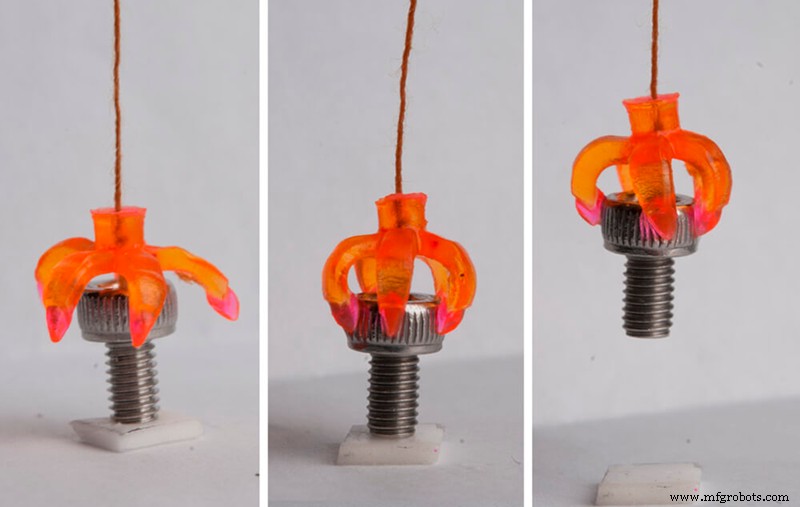4D-печать:будущее 3D-печати
Что, если бы трубы могли автоматически чинить себя? если они трескаются или ломаются, или одежда может меняться в зависимости от погоды или деятельности пользователя ? Мебель, которая собирается сама, протезы, которые адаптируются к росту... Это лишь некоторые из возможных применений, которые предполагается реализовать с помощью технологии 4D-печати.

Изображение 1:напечатанный на 4D-принтере коготь изменил свою форму. Источник:Sculpteo.
3D-печать существует уже почти 30 лет, и пока он все еще находится в процессе исследований, открытия новых материалов и приложений, появились новые технологии, такие как 4D.
В лаборатории самосборки Массачусетского технологического института , они разработали проект, частью которого является 4D-печать. Его цель – объединить технологии и дизайн для изобретения программируемых материалов. и технологии самостоятельной сборки с целью переосмысления конструкции, производства, сборки и производительности продукции. Тем временем исследование Института Висса (часть Гарвардского университета) удалось напечатать объект, который при контакте с водой меняет свою форму д., что приводит к своеобразному распусканию его концов. Они разработали материал на основе природных структур, таких как растения, в которые в процессе печати вводили волокна целлюлозы.
Видео 1. Архитектура, меняющая форму. Источник:Гарвардский университет.
Что такое 4D-печать?
Вдохновленный принципом самосборки, 4D-печать представляет собой процесс, в ходе которого 3D-печатный объект преобразуется в другую структуру под воздействием внешней энергии, такой как температура, свет или другие воздействия окружающей среды. То есть получение с помощью 3D-технологии объекта, который благодаря свойствам материала, из которого он изготовлен, способен изменяться под воздействием внешних воздействий.
Именно в этом различие между технологиями 3D и 4D:способность объектов трансформироваться с течением времени без вмешательства человека.
Использованные материалы
Ключ к 4D-печати не столько в процессе , основанные на знакомых 3D-принтерах,но материалы. Поскольку это довольно новая технология, доступные материалы не так разнообразны, как те, которые используются для стандартной 3D-печати. Однако есть и очень интересные.
SMP (полимеры с памятью формы)
Полимеры, которые остаются жесткими при комнатной температуре и проявляют особые свойства, когда достигают точки стеклования. Примером может служить TPU SMP от Convena:четырехмерная нить с композицией на основе TPU. (термопластичный полиуретан), который позволяет в процессе постобработки изменять форму напечатанных на 3D-принтере деталей. Благодаря особому составу и технологии полимера с памятью формы, parts printed with this filament can be modified manually, allowing them to acquire another shape and maintain it over time.
The process of modifying the shape of a 3D printed part with SMP TPU filament consists of placing the 3D printed part in a container of hot water until it reaches its glass transition temperature. At this point, the part softens and the user can easily modify its shape. Once cooled, the part maintains the acquired shape and remains stable. In addition, parts 3D printed with SMP TPU filament can be restored to their original shape by reversing the process. In other words, the material's glass transition temperature is reached again.
LCE (liquid crystal elastomers)
They contain liquid crystals that are sensitive to heat. By controlling their orientation, the desired shape can be programmed: under the effect of temperature, the material will relax and transform according to the dictated code.
Hydrogels
Polymer chains consisting mainly of water , particularly used in light-curing processes. The latter are focused on the medical sector due to their biocompatibility.
In addition, some 4D printing processes can use various materials, mainly composites such as wood or carbon, which are added to SMP or hydrogels. This results in objects with rigid and movable areas.
Приложения
Given the many advantages of such intelligent materials, the applications of 4D printing are innumerable.
Construction
The construction of climate-adapted structures such as bridges, shelters or other facilities would be a huge step forward in this field. 4D bricks capable of modifying walls and roofs to suit the environment would allow indoor conditions to be modified and improved.
Video 2:Programmable wood. Source:Self-Assembly Lab, MIT.
Medicine
In this case, 4D printing offers the possibility to create tailor-made, intelligent and evolving devices. For example, by 4D printing an implant, its condition and viability could be more easily monitored once it is integrated into the patient.
This concept is applicable to all regenerative medicine and the fabrication of cellular structures. 4D printing would allow cells to adapt to the human body depending on its temperature, Например. If we talk about medicines, it would be possible, for example, to print a device that would release the required dose depending on the patient's body temperature.
Transport
A few months ago, BMW and MIT presented their inflatable material, which changes shape and size under the effect of air pulses. The applications are very interesting, as in the future we could have tyres that can repair themselves in case of a puncture or adapt to the terrain and weather conditions of the environment.
In the case of the aircraft industry, a 4D printed component could react to atmospheric pressure or temperature changes and thus change its function. Airbus is currently working on such developments, as these components could replace hinges and hydraulic actuators, significantly lightening the devices . In addition, it is also working on the development of heat-reactive materials to cool its aircraft engines.
Raúl Pulido Casillas, a Spanish engineer, has created a 4D-printed smart fabric for NASA. The metallic mesh, made of silver pieces joined together, has thermal regulation programmed into its print. In other words, not only its shape has been printed, but also the function of the materials. As it is able to reflect heat on the outside and retain it on the inside, it could be an ideal element for making astronaut suits or covering spacecraft.
Fashion
In the textile industry, 4D printing is also finding its place. The possibility of printing shoes that adapt to movement, impact, temperature and atmospheric pressure is a possibility. The US military has already made a foray into this field and is testing uniforms that change colour depending on the environment, or that regulate perspiration depending on the soldier's pulse or the ambient temperature.
Although we are still in its infancy, it is certain that 4D technology will revolutionise the manufacture and nature of objects over the next few years, just as 3D printing did in its day.
3D печать



